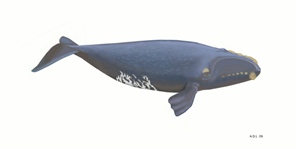Species Index


Key Facts
Length: Up to 18 metresRange: Atlantic Ocean
Threats: Ship strikes, pollution
Diet: Plankton
North Atlantic Right Whale
Latin: Eubalaena glacialis
Physical Description
The North Atlantic right whale is a large, robust-bodied animal that can measure up to 18 metres in length. The main distinguishing feature is the lack of a dorsal fin. The mouth line is arched and there are no throat pleats. There are commonly rough patches of skin, known as callosities, on the head and lower jaw, which appear white due to infestations of whale lice (cyamids). Pectoral fins are broad and paddle-shaped and the tail is large with a smooth trailing edge. The blow is V-shaped and the tail fluke is normally raised upon diving. Northern right whales are black with white patches on the belly.
Habitat and Distribution
There are two species of northern right whale currently recognised: North Atlantic (Eubalaena glacialis) and North Pacific (Eubalaena japonica). The North Atlantic right whale occurs off the east coast of America and Canada, and is very rarely seen on the eastern side of the Atlantic Ocean. They are occasionally seen offshore in deeper waters, but are more frequently seen in coastal waters and around continental shelf regions. They undertake seasonal migrations between feeding and breeding grounds. North Atlantic right whales may once have been more common along the west coast of Scotland but they are now very rare in European waters due to previous extensive whaling.
Behaviour
North Atlantic right whales are often seen singly or in groups of two or three animals but larger groups may occur at feeding grounds or during courtship. Breaching and flipper slapping are observed off the American and Canadian coast, and whales will occasionally approach boats.
Food and Foraging
Feeding exclusively on plankton, North Atlantic right whales swim with their mouths open continually filtering prey through their baleen.
Status and Conservation
The global population is currently estimated at 300 to 350 animals and the species is classified as ‘Endangered’ on the IUCN Red List of Threatened Species. Extensive whaling targeted northern right whales for ten centuries causing the significant decline of the species. Today, collisions with ships are a major cause of mortality for the remaining whales and this prompted the US government to introduce shipping restrictions to address this issue. Northern right whales are protected under UK and EU law, principally under Schedule 5 of the Wildlife and Countryside Act 1981, the Nature Conservation (Scotland) Act 2004 and by the 1992 EU Habitats and Species Directive.





